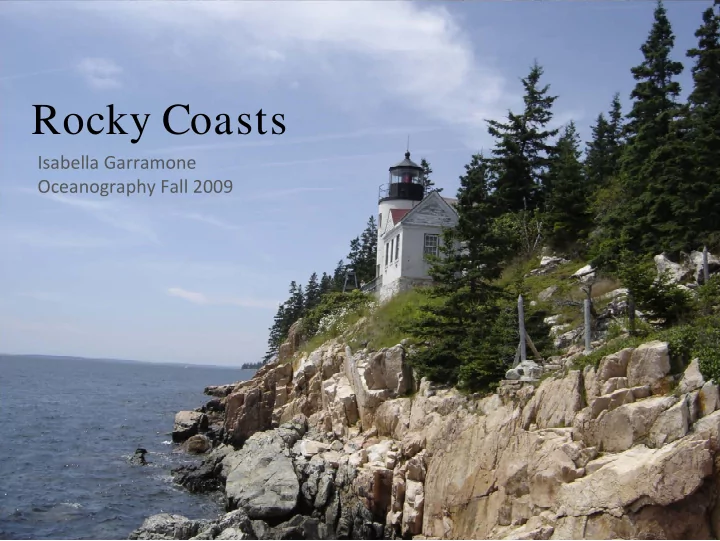

Rocky Coasts Isabella Garramone Oceanography Fall 2009
General Overview • 75% of the world’s coasts are rocky. • “As with most landforms rocky shores reflect the structure and strength of the exposed lithologies, the physical and chemical processes acting on them, and the time they're allowed to do so. “ • Waves approach a shoreline from all sides in varying angles. • The surf erodes softer rock faster than the surrounding rock. • Rocky coasts have a narrow continental shelf that pitches sharply from land to sea.
Shaping of Rocky Coasts • Physical Weathering: the erosion of land by waves, wind, or the movement of glaciers. • Chemical Weathering: hydrolysis, oxidation, and salt weathering. • Bioerosion: the erosion of land by algae or other organisms that either dissolve layers of rock or tunnel into it. � Mainly on coasts made of carbonate. Limestone bored by clams and sponges (bioerosion).
Geologic Features of Rocky Coasts • Fjords: formed when glacial valleys fill with water when the sea lever rises. • Pocket Beaches: protected embayments where wave action is subdued and sediment is not carried away. • Sea Caves: carved out from bedrock by prolonged wave action. • Sea Cliffs: a very steep slope separates flat land from the water. • Sea Arches and Sea Stacks: isolated remnants of the mainland that will eventually be completely eroded away.
Pocket Sea Cliff •After caving in, a sea arch becomes a sea stack which will eventually become a sea stump.
Where are Rocky Coasts Found? • Found where there is a history of erosion exceeding rates of sedimentation, or sediment is either low or not retained. • Active Tectonic Environments – volcanic islands: rapid uplift inhibits the development of sediment equilibrium (reef development is common) – Example: parts of the coast of California • Where Mountains and the Sea collide • Where glaciers played a large role in carving out the landscape; rapid glacial escape leaves little material behind to make beaches. – Examples: Maine & Alaska
Shipwreck Coast: Victoria, Australia • Shipwreck Coast is made primarily of limestone. • There are numerous sea stacks in the water & underwater rock formations that have sunken more than 200 ships.
Species that Live on Rocky Coasts • Many species live in tide pools on top of the rocks, such as snails and macroinvertebrates. • Algae, such as bladderwort, clings and grows off of the rocks. • Smaller fish & organisms (such as juvenile lobsters) find refuge from predators in the underwater crevices the rocks provide. • The animals living in the intertidal zones must be able to withstand being underwater and above water for prolonged periods. • Barnacles attach themselves to the rocks as a base and use it as leverage to sweep the surrounding area for plankton.
Rocky Coasts + Global Climate Change • As glaciers melt and sea level rises, rocky coastlines will become even more eroded than before. • Many sea arches and sea stacks will tumble or some sea caves may enlarge or cave in. • Increasingly turbulent storms as a results of warmer waters will erode the exposed rocks more rapidly. • The waves produced by these larger storms will also erode the rocks at sea level more rapidly.
Works Cited Hanson, Lindsay S., . "Rocky Coasts." Geomorphology . Salem State College • Department of Geological Sciences, Web. 23 Sep 2009. <http://w3.salemstate.edu/~lhanson/gls214/gls214_rocky.html> "Oceans." Erosional and Depositional Features of Waves . Vancouver School Board, • Web. 24 Sep 2009. <http://stloe.most.go.th/html/lo_index/LOcanada6/606/6_en.htm>. "Rocky Coasts." Geologic Features of Rocky Coasts . National Park Service, Web. 24 • Sep 2009. <http://www.teachersdomain.org/ext/ess05_int_coastrock/05_R_GeoFeatures.ht m>. Wilson, Mark A., . "Bioerosion." The College of Wooster Department of Geology, • Web. 23 Sep 2009. <http://www3.wooster.edu/geology/Bioerosion/Bioerosion.html >.
Recommend
More recommend